Recently, I have had a strong urge to revisit Magic: The Gathering. I played almost every day in high school, dabbled in college, and ultimately got sucked into Magic Online in 2009. Since then, however, I gradually parted ways with Magic and was now curious to see where the digital state of Magic currently resides. So, I downloaded Magic Duels from Steam (free to play, released July, 2015) and Magic 2015 for android (free, released July, 2014; however, the PC version is $9.99). Although I have not played the PC version, I included the price for comparison’s sake because the features I will be discussing are similar in both versions.
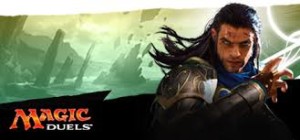 VERSUS
VERSUS 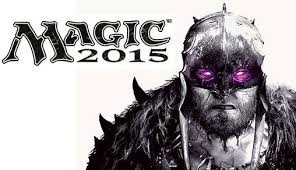
Tutorials/skill quests in Magic Duels
Both games have intuitive and comprehensive tutorials at the beginning, which is entirely understandable because Magic can be an incredibly complex and strategic game.
However, there is one usability issue worth noting in Magic Duels; there are skill quests that arise during certain scenarios during tutorial duels, which present themselves as pop ups in the middle of the duel. There are many different skill quests and each pop up contains information regarding what can be learned by completing it. There is the option to “X” out of the skill quest, indicating that it is optional; however, it is never clarified if the player can resume the duel in progress if the skill quest is pursued. Additionally, it is never stated if the player will have the option to complete the skill quest in the future if the skill quest is not completed at that moment (after some time searching through the menus, the skill quests can indeed be played at any time). With that being said, it took a few moments to weigh all of these possible scenarios when I encountered the first skill quest. Ultimately, I proceeded with the quest and, fortunately, was able to resume the duel in progress. It would have been a much more streamlined process if there was information of this presented prior to this decision being made. On the other hand, there are no such skill quests in Magic 2015, so this issue is avoided altogether.
User interface differences
In addition to some differences in available quests, there are also significant interface differences in Magic Duels and Magic 2015.
Magic Duels offers helpful visual cues, which direct your attention to the relevant portion of the game board at that moment; this is a helpful feature because, as previously mentioned, Magic can get complicated, and is a series seemingly seeking to broaden its reach to new players, as evidenced, primarily, by its user-friendly tutorial system. Examples of these cues include the borders of playable cards being lit up, indicating that they are playable at that specific moment, as well as flashes to avatars when damage is dealt. Also, there is an eye-level bar in the middle of the screen (see picture below) which incorporates both visual and verbal cues to the player, indicating whose turn it is, as well as what the current phase is. Also, this can be extremely helpful to newer players since the phases can be completed very quickly, making it easy to lose track.
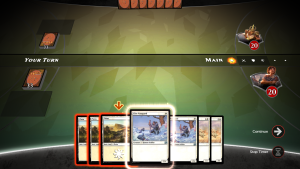
In Magic 2015, there is a different UI that indicates player turn and phase. There are small diamonds next to each player’s avatar, which light up during specific phases, as well as a mini loading-bar style indicator and verbal cue. Again, with how quickly the game of Magic can move, this much-more subtle system can make it harder to track player turn and phase, which is critical information to be aware of.
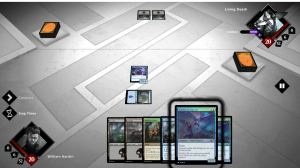
Card collection UI
Adding new cards to your collection and assembling new decks are probably two of, if not the, most fun aspects of Magic. If you aren’t working with a physical deck of cards and don’t have the freedom to follow your own strategy, it is imperative that the interface to arrange digital cards be intuitive and user-friendly.
Magic 2015 has a slick UI for card collection. On the top of the screen, there is a minimizable box with numerous filtering options. As one can imagine, an avid Magic player can build quite the collection of cards. The amount and variety of cards demands an abundance of options in order to sort through your collection and find what you’re looking for efficiently. Magic 2015 allows you to sort by card type, rarity, cost, and color. Card type is represented by rectangular boxes, while card rarity, cost, and color are represented by diamonds. When considering this UI menu in terms of Gestalt principles of perception, the representation of card by rectangular boxes adheres nicely to the law of similarity. However, upon first glance of card rarity, cost, and color, it can be a bit difficult to differentiate where each category begins and ends because they are all represented as diamonds (see picture below). Ideally, these three categories would be represented by different shapes. However, the addition of relevant symbols within the diamonds as well as the categorical text above them certainly helps resolve this issue. These symbols and text ultimately help the organization of the card rarity, cost, and color categories, but additional space between the three would be beneficial to see them as three separate entities (and to abide by the law of proximity) rather than one long snake-like row of diamonds, ultimately making it much more effortless to comprehend, especially for new players who might not know what the symbols inside the diamonds represent.
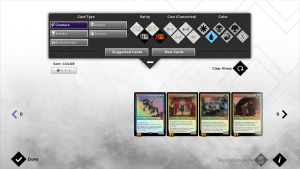
Magic Duels does not offer the same options when it comes to filtering options in the card collection. While Magic 2015 presents everything on the screen at once, Magic Duels presents an overlay with minimal filtering options (see picture below). Card color and set are the only options available for filtering, with no way to search for by card type, cost, or rarity. Additionally, to submit filtering options from this screen, you have to press the “X” in the top right hand corner, which many players might associate with “exit” and not necessarily “save and exit.” This lack of options makes sorting through your collection an absolute chore.
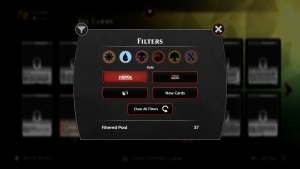
Deck builder UI
Similar to the card collection menu in Magic 2015, the deck builder contains a minimizable box that contains pertinent information such as the breakdown of spells in your deck, color distribution, mana curve, and ratings on important traits of your deck such as speed, strength, control, and synergy. This is all available without fumbling through any additional menus, whereas, in Magic Duels, the deck builder only provides information on the color of the cards in your deck and a breakdown by mana cost. For any other information you might want to know about the deck you just built, such as speed, strength, control, and synergy, you have to go back to the main menu for the deck builder. The have-it-all-accessible-on-one-screen layout of Magic 2015 made building a deck a pleasure compared to Magic Duels, where most time seems to be spent cycling through menu screens.
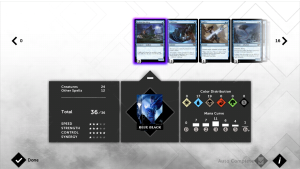
Conclusion
Gameplay-wise, there seems to be a significant pay-to-play philosophy inherent in Magic 2015 because you can only play the tutorial as well as a few single-player campaign matches, whereas everything else you have to pay for. In contrast, Magic Duels has significantly more to do without forking over real money; however, it leaves much to be desired in terms of usability, whereas Magic 2015 has, for the most part, slick, intuitive UI with no shortage of filtering options within its menus. While I realize the experience of the UI in Magic 2015 might be more intuitive on mobile (where I played it) compared to PC, and some might consider this comparing apples to oranges, usability features and design should be catered to the format in which it is going to be played. Ultimately, if the UI for Magic 2015 isn’t nearly as functional/intuitive on PC as it is on mobile, that is a major oversight on the developer’s part, and not all usability/UI features should just be ported.
With that being said, let me remind you that Magic Duels was released a year after Magic 2015, so the UI layout of Magic 2015 has been around and is not new to the digital world of Magic. If the UI of Magic 2015 is indeed not as functional/intuitive on PC as it is on mobile, especially since both games are by Stainless Games, why couldn’t a better system (intuitive for PC use), incorporating some of the positive elements of Magic 2015’s UI, such as the card collection and deck builder menus (or something similar), have been implemented into Magic Duels? Is it because it is a free-to-play game and therefore certain features, like intuitive usability, get overlooked? Or, is it because developers need to start taking usability/user experience more seriously? More attention allotted to the usability of fundamental aspects of Magic: The Gathering, such as building decks and collecting cards, would have made Magic Duels a more complete experience and, ultimately, a progression in the right direction for the series rather than stagnation.
